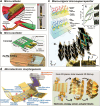Unlocking Micro-Origami Energy Storage
- PMID: 39734918
- PMCID: PMC11672231
- DOI: 10.1021/acsaem.4c00702
Unlocking Micro-Origami Energy Storage
Abstract
Transforming thin films into high-order stacks has proven effective for robust energy storage in macroscopic configurations like cylindrical, prismatic, and pouch cells. However, the lack of tools at the submillimeter scales has hindered the creation of similar high-order stacks for micro- and nanoscale energy storage devices, a critical step toward autonomous intelligent microsystems. This Spotlight on Applications article presents recent advancements in micro-origami technology, focusing on shaping nano/micrometer-thick films into three-dimensional architectures to achieve folded or rolled structures for microscale energy storage devices. Micro-Swiss-rolls, created through a roll-up process actuated by inherent strain in multiple layer stacks, have been employed to develop on-chip microbatteries and microsupercapacitors with superior performance compared to their planar counterparts. The technology allows additional functionalities to be integrated into the same device using multifunctional materials. Despite significant progress, the key challenge for micro-origami technology in creating microscale energy storage devices lies in diversifying shape-morphing mechanisms to expand material choices, improve process reliability, and enhance reproducibility. Additionally, developing a universal microscale energy storage device that can cater to various tiny devices is intricate. Therefore, considering the integration of energy storage into final applications during the development phase is crucial. Micro-origami energy storage systems are poised to significantly impact the future of autonomous tiny devices, such as smart dust and microrobots.
© 2024 The Authors. Published by American Chemical Society.
Conflict of interest statement
The authors declare no competing financial interest.
Figures







References
-
- Lee G.; Wei Q.; Zhu Y. Emerging Wearable Sensors for Plant Health Monitoring. Adv. Funct. Mater. 2021, 31 (52), 2106475.10.1002/adfm.202106475. - DOI
-
- Warneke B.; Last M.; Liebowitz B.; Pister K. S. J. Smart Dust: Communicating with a Cubic-Millimeter Computer. Computer 2001, 34 (1), 44–51. 10.1109/2.895117. - DOI
-
- Huang T.-Y.; Gu H.; Nelson B. J. Increasingly Intelligent Micromachines. Annu. Rev. Control Robot. Auton. Syst. 2022, 5 (1), 279–310. 10.1146/annurev-control-042920-013322. - DOI
-
- Xu B.; Kong L.; Wen G.; Pecht M. G. Protection Devices in Commercial 18650 Lithium-Ion Batteries. IEEE Access 2021, 9, 66687–66695. 10.1109/ACCESS.2021.3075972. - DOI
Publication types
LinkOut - more resources
Full Text Sources
Other Literature Sources
